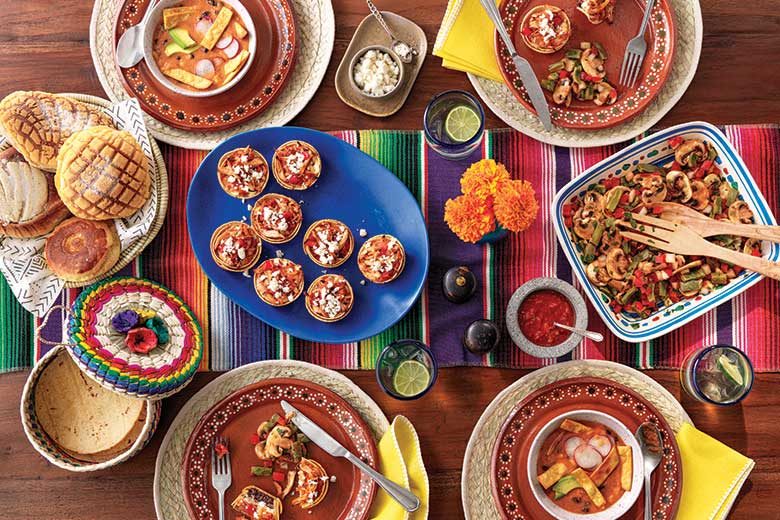
Mexican cuisine is well-known around the world thanks to its delicious flavors and variety of ingredients, colors and condiments. In fact, Mexican cuisine was declared an “Intangible Cultural Heritage of Humanity” in 2010 by the United Nations Educational, Scientific and Cultural Organization.
Mouth-watering Mexican dishes including tacos, guacamole, enchiladas, salsa verde, tamales and quesadillas are a fusion of two worlds: Through these foods, we see the history of Mexico, both before and after the colonization by the Spanish.
Ancient Mexican or pre-Hispanic cuisine from the Aztecs, Toltecs and Mayans was completely different from what we eat now. The diet of these ancient Mexican civilizations was simple, yet included many healthy foods. For example, Aztecs consumed mostly low-fat, plant-based foods such as beans; grains (mainly in the form of maize); vegetables such as squash and nopales (cactus); seeds such as chia and pumpkin; and a variety of chili peppers. Aztecs also ate small amounts of animal-based protein from small animals such as turkey, guinea pigs and iguanas. Grasshoppers, ants and insect eggs were prepared on special occasions.
When the Spaniards conquered Mexico, they introduced European flavors and ingredients including meat from cows and pigs, cheese, rice, onions and garlic. Today, we can see these two worlds fused into a single dish — for example, the quesadilla: a tortilla with cheese.
No matter where you go in Mexico, tortillas, beans and salsas are always part of a meal. These three staples nutritionally complement each other. To make tortillas, corn is soaked in lime-treated water with calcium hydroxide, a process that increases the bioavailability of niacin and the content of calcium and soluble fiber. Beans are a source of plant-based protein, fiber, iron and many other nutrients. Salsas are usually made with different chili peppers and vegetables such as tomatoes and tomatillos. These ingredients, especially chili peppers, are high in vitamin C, which helps the body absorb non-heme iron in beans. They also provide fiber and antioxidants.
As in many cultures, food is present at every family celebration or reunion. We even offer food to our deceased family members during Día de Los Muertos (Day of the Dead). “Secret” family recipes for special celebration dishes are passed from generation to generation, usually by las abuelitas (grandmothers), who are the keepers of family recipes. I remember reading my grandmother’s recipe book. She never used measuring cups, scales or any other gadget to measure ingredients, and the recipes hardly had any instructions. All of it was written in her mind. My grandmother used her hands to measure ingredients such as a pizca (pinch) or un puño (a handful). She said that only with experience and practice can one master these recipes.
One of the reasons Mexican food is so delicious is that its ingredients are fresh and local. In Mexico, it is normal to go almost every day to the mercados (fresh markets) to buy fresh food, pots, flowers or even to eat authentic Mexican street food. Mercados are full of traditions. Depending on the time of year, you will find seasonal ingredients and products. For instance, in December, you can find ingredients for ponche (Christmas fruit punch), bacalao (cod) and even beautifully decorated piñatas for the posadas. Posadas are a very traditional celebration of the story of Joseph and Mary’s journey to Bethlehem. When I was a kid, we stuffed piñatas with fruits such as mandarins and oranges, sugar canes and lots of peanuts in the shell. Every time the piñata broke, kids would quickly run and try to grab as much as possible. After all this excitement, we sat on the floor and started eating — we even ate the sugar cane with our bare hands! Nowadays, piñatas are stuffed with candy and plastic toys.
Whether in Mexico or in the U.S., I recommend immersing yourself in the authentic Mexican gastronomy. When visiting Mexico, go to mercados and restaurants outside the touristy areas. In the U.S., you can easily find authentic Mexican ingredients by going to Mexican or Latin-American grocery stores and restaurants. Let this adventure awaken your senses and take you through the history of Mexico.
References
Intangible Cultural Heritage. United Nations Educational, Science and Cultural Organization website. Accessed February 1, 2019.
Serna-Saldívar SO, Gómez MH, Rooney L. Technology, chemistry and nutritional value of alkaline-cooked corn products. Advances in Cereal Science and Technology. 1990; 10:243-307.




